Native/Alaskan vs Indian (Asian) Community Comparison
COMPARE
Native/Alaskan
Indian (Asian)
Social Comparison
Social Comparison
Natives/Alaskans
Indians (Asian)
1,140
SOCIAL INDEX
9.0/ 100
SOCIAL RATING
321st/ 347
SOCIAL RANK
7,850
SOCIAL INDEX
76.0/ 100
SOCIAL RATING
101st/ 347
SOCIAL RANK
Indian (Asian) Integration in Native/Alaskan Communities
The statistical analysis conducted on geographies consisting of 458,459,363 people shows a poor positive correlation between the proportion of Indians (Asian) within Native/Alaskan communities in the United States with a correlation coefficient (R) of 0.121. On average, for every 1% (one percent) increase in Natives/Alaskans within a typical geography, there is an increase of 0.005% in Indians (Asian). To illustrate, in a geography comprising of 100,000 individuals, a rise of 1,000 Natives/Alaskans corresponds to an increase of 4.8 Indians (Asian).
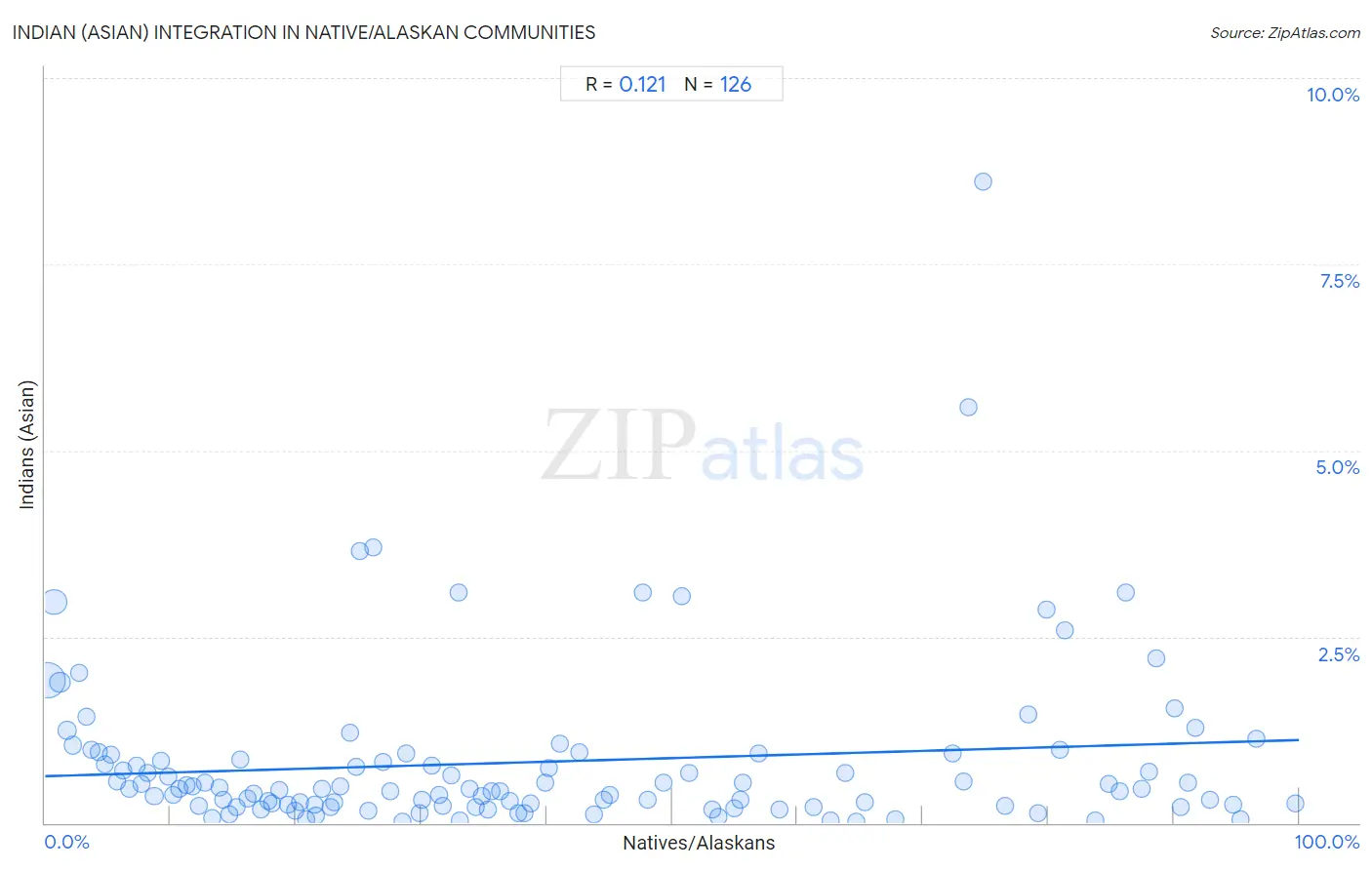
Native/Alaskan vs Indian (Asian) Income
When considering income, the most significant differences between Native/Alaskan and Indian (Asian) communities in the United States are seen in per capita income ($33,279 compared to $53,874, a difference of 61.9%), householder income ages 25 - 44 years ($75,647 compared to $119,496, a difference of 58.0%), and median household income ($67,879 compared to $105,262, a difference of 55.1%). Conversely, both communities are more comparable in terms of wage/income gap (24.6% compared to 26.4%, a difference of 7.6%), householder income under 25 years ($47,704 compared to $58,239, a difference of 22.1%), and householder income over 65 years ($52,081 compared to $70,238, a difference of 34.9%).

| Income Metric | Native/Alaskan | Indian (Asian) |
| Per Capita Income | Tragic $33,279 | Exceptional $53,874 |
| Median Family Income | Tragic $80,908 | Exceptional $125,312 |
| Median Household Income | Tragic $67,879 | Exceptional $105,262 |
| Median Earnings | Tragic $38,896 | Exceptional $56,253 |
| Median Male Earnings | Tragic $44,775 | Exceptional $66,078 |
| Median Female Earnings | Tragic $33,806 | Exceptional $46,481 |
| Householder Age | Under 25 years | Tragic $47,704 | Exceptional $58,239 |
| Householder Age | 25 - 44 years | Tragic $75,647 | Exceptional $119,496 |
| Householder Age | 45 - 64 years | Tragic $79,816 | Exceptional $122,343 |
| Householder Age | Over 65 years | Tragic $52,081 | Exceptional $70,238 |
| Wage/Income Gap | Exceptional 24.6% | Poor 26.4% |
Native/Alaskan vs Indian (Asian) Poverty
When considering poverty, the most significant differences between Native/Alaskan and Indian (Asian) communities in the United States are seen in child poverty under the age of 5 (25.6% compared to 13.4%, a difference of 90.0%), family poverty (14.3% compared to 7.7%, a difference of 85.0%), and female poverty among 25-34 year olds (20.3% compared to 11.2%, a difference of 81.6%). Conversely, both communities are more comparable in terms of seniors poverty over the age of 75 (15.5% compared to 12.7%, a difference of 21.6%), seniors poverty over the age of 65 (14.2% compared to 11.1%, a difference of 28.3%), and female poverty among 18-24 year olds (25.4% compared to 19.6%, a difference of 29.7%).
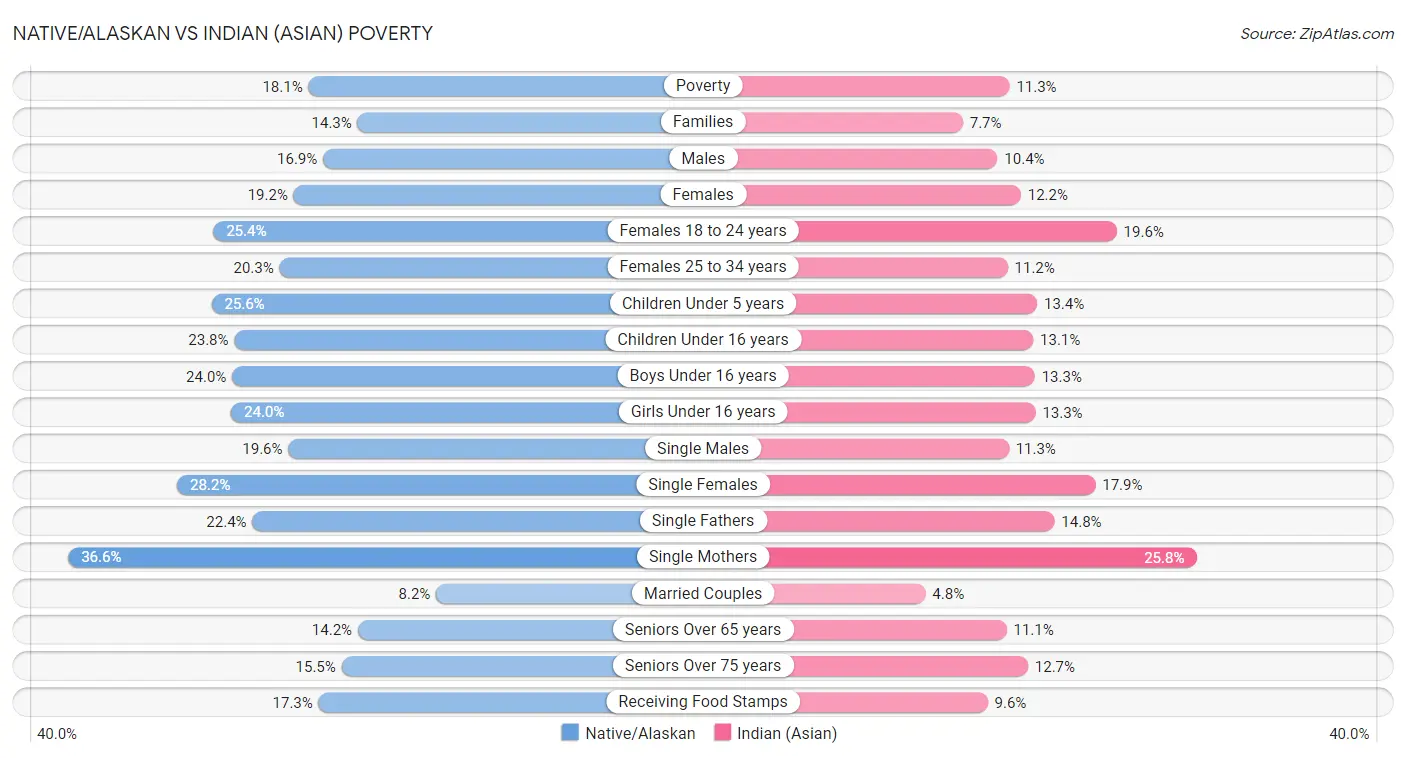
| Poverty Metric | Native/Alaskan | Indian (Asian) |
| Poverty | Tragic 18.1% | Exceptional 11.3% |
| Families | Tragic 14.3% | Exceptional 7.7% |
| Males | Tragic 16.9% | Exceptional 10.4% |
| Females | Tragic 19.2% | Exceptional 12.2% |
| Females 18 to 24 years | Tragic 25.4% | Excellent 19.6% |
| Females 25 to 34 years | Tragic 20.3% | Exceptional 11.2% |
| Children Under 5 years | Tragic 25.6% | Exceptional 13.4% |
| Children Under 16 years | Tragic 23.8% | Exceptional 13.1% |
| Boys Under 16 years | Tragic 24.0% | Exceptional 13.3% |
| Girls Under 16 years | Tragic 24.0% | Exceptional 13.3% |
| Single Males | Tragic 19.6% | Exceptional 11.3% |
| Single Females | Tragic 28.2% | Exceptional 17.9% |
| Single Fathers | Tragic 22.4% | Exceptional 14.8% |
| Single Mothers | Tragic 36.6% | Exceptional 25.8% |
| Married Couples | Tragic 8.2% | Exceptional 4.8% |
| Seniors Over 65 years | Tragic 14.2% | Fair 11.1% |
| Seniors Over 75 years | Tragic 15.5% | Tragic 12.7% |
| Receiving Food Stamps | Tragic 17.3% | Exceptional 9.6% |
Native/Alaskan vs Indian (Asian) Unemployment
When considering unemployment, the most significant differences between Native/Alaskan and Indian (Asian) communities in the United States are seen in unemployment among women with children under 6 years (11.5% compared to 6.3%, a difference of 83.0%), unemployment among ages 35 to 44 years (7.3% compared to 4.4%, a difference of 63.9%), and unemployment among ages 30 to 34 years (8.2% compared to 5.1%, a difference of 60.5%). Conversely, both communities are more comparable in terms of unemployment among seniors over 65 years (5.8% compared to 5.2%, a difference of 12.0%), unemployment among ages 60 to 64 years (5.7% compared to 5.0%, a difference of 12.8%), and unemployment among ages 65 to 74 years (6.0% compared to 5.3%, a difference of 13.0%).
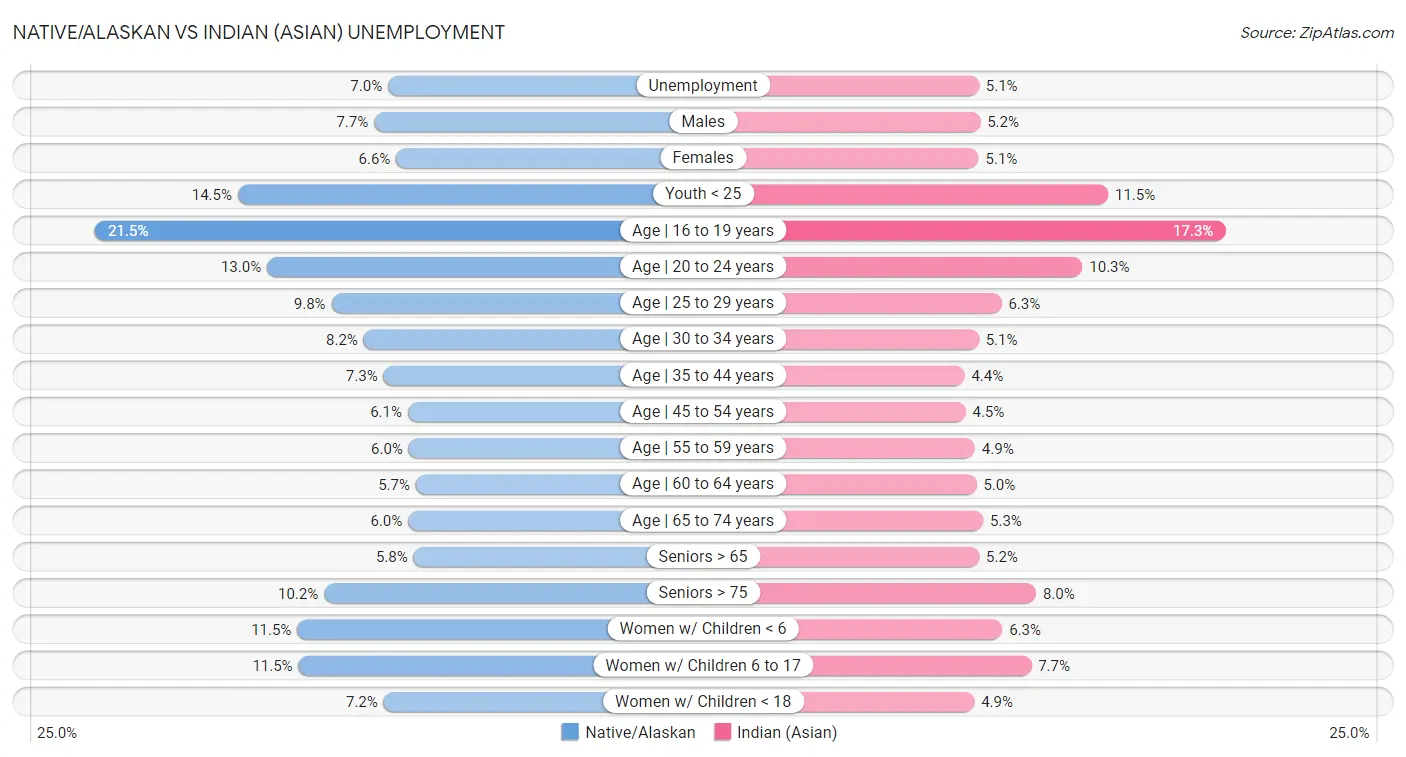
| Unemployment Metric | Native/Alaskan | Indian (Asian) |
| Unemployment | Tragic 7.0% | Excellent 5.1% |
| Males | Tragic 7.7% | Good 5.2% |
| Females | Tragic 6.6% | Excellent 5.1% |
| Youth < 25 | Tragic 14.5% | Good 11.5% |
| Age | 16 to 19 years | Tragic 21.5% | Good 17.3% |
| Age | 20 to 24 years | Tragic 13.0% | Good 10.3% |
| Age | 25 to 29 years | Tragic 9.8% | Exceptional 6.3% |
| Age | 30 to 34 years | Tragic 8.2% | Exceptional 5.1% |
| Age | 35 to 44 years | Tragic 7.3% | Exceptional 4.4% |
| Age | 45 to 54 years | Tragic 6.1% | Good 4.5% |
| Age | 55 to 59 years | Tragic 6.0% | Tragic 4.9% |
| Age | 60 to 64 years | Tragic 5.7% | Tragic 5.0% |
| Age | 65 to 74 years | Tragic 6.0% | Average 5.3% |
| Seniors > 65 | Tragic 5.8% | Average 5.2% |
| Seniors > 75 | Tragic 10.2% | Exceptional 8.0% |
| Women w/ Children < 6 | Tragic 11.5% | Exceptional 6.3% |
| Women w/ Children 6 to 17 | Tragic 11.5% | Exceptional 7.7% |
| Women w/ Children < 18 | Tragic 7.2% | Exceptional 4.9% |
Native/Alaskan vs Indian (Asian) Labor Participation
When considering labor participation, the most significant differences between Native/Alaskan and Indian (Asian) communities in the United States are seen in in labor force | age 16-19 (36.6% compared to 31.9%, a difference of 14.7%), in labor force | age > 16 (60.6% compared to 65.5%, a difference of 8.1%), and in labor force | age 20-64 (73.9% compared to 79.9%, a difference of 8.1%). Conversely, both communities are more comparable in terms of in labor force | age 20-24 (72.4% compared to 71.9%, a difference of 0.76%), in labor force | age 25-29 (79.3% compared to 84.7%, a difference of 6.9%), and in labor force | age 35-44 (78.9% compared to 84.8%, a difference of 7.5%).

| Labor Participation Metric | Native/Alaskan | Indian (Asian) |
| In Labor Force | Age > 16 | Tragic 60.6% | Excellent 65.5% |
| In Labor Force | Age 20-64 | Tragic 73.9% | Excellent 79.9% |
| In Labor Force | Age 16-19 | Average 36.6% | Tragic 31.9% |
| In Labor Force | Age 20-24 | Tragic 72.4% | Tragic 71.9% |
| In Labor Force | Age 25-29 | Tragic 79.3% | Good 84.7% |
| In Labor Force | Age 30-34 | Tragic 79.2% | Exceptional 85.4% |
| In Labor Force | Age 35-44 | Tragic 78.9% | Exceptional 84.8% |
| In Labor Force | Age 45-54 | Tragic 77.1% | Exceptional 83.3% |
Native/Alaskan vs Indian (Asian) Family Structure
When considering family structure, the most significant differences between Native/Alaskan and Indian (Asian) communities in the United States are seen in births to unmarried women (43.0% compared to 25.3%, a difference of 70.1%), single father households (3.2% compared to 1.9%, a difference of 68.2%), and single mother households (8.0% compared to 5.1%, a difference of 57.1%). Conversely, both communities are more comparable in terms of family households (66.4% compared to 65.1%, a difference of 1.9%), family households with children (28.4% compared to 27.6%, a difference of 3.0%), and average family size (3.45 compared to 3.24, a difference of 6.4%).

| Family Structure Metric | Native/Alaskan | Indian (Asian) |
| Family Households | Exceptional 66.4% | Exceptional 65.1% |
| Family Households with Children | Exceptional 28.4% | Good 27.6% |
| Married-couple Households | Tragic 43.5% | Exceptional 48.7% |
| Average Family Size | Exceptional 3.45 | Good 3.24 |
| Single Father Households | Tragic 3.2% | Exceptional 1.9% |
| Single Mother Households | Tragic 8.0% | Exceptional 5.1% |
| Currently Married | Tragic 42.8% | Exceptional 48.0% |
| Divorced or Separated | Tragic 13.0% | Exceptional 10.2% |
| Births to Unmarried Women | Tragic 43.0% | Exceptional 25.3% |
Native/Alaskan vs Indian (Asian) Vehicle Availability
When considering vehicle availability, the most significant differences between Native/Alaskan and Indian (Asian) communities in the United States are seen in no vehicles in household (10.5% compared to 14.1%, a difference of 34.0%), 4 or more vehicles in household (8.2% compared to 6.4%, a difference of 27.3%), and 3 or more vehicles in household (22.7% compared to 19.1%, a difference of 19.0%). Conversely, both communities are more comparable in terms of 1 or more vehicles in household (89.8% compared to 86.0%, a difference of 4.4%), 2 or more vehicles in household (57.0% compared to 53.1%, a difference of 7.3%), and 3 or more vehicles in household (22.7% compared to 19.1%, a difference of 19.0%).

| Vehicle Availability Metric | Native/Alaskan | Indian (Asian) |
| No Vehicles Available | Average 10.5% | Tragic 14.1% |
| 1+ Vehicles Available | Average 89.8% | Tragic 86.0% |
| 2+ Vehicles Available | Exceptional 57.0% | Tragic 53.1% |
| 3+ Vehicles Available | Exceptional 22.7% | Fair 19.1% |
| 4+ Vehicles Available | Exceptional 8.2% | Good 6.4% |
Native/Alaskan vs Indian (Asian) Education Level
When considering education level, the most significant differences between Native/Alaskan and Indian (Asian) communities in the United States are seen in professional degree (3.0% compared to 6.5%, a difference of 120.7%), doctorate degree (1.3% compared to 2.9%, a difference of 119.8%), and master's degree (9.9% compared to 20.5%, a difference of 105.9%). Conversely, both communities are more comparable in terms of 8th grade (95.2% compared to 95.2%, a difference of 0.060%), 7th grade (95.6% compared to 95.5%, a difference of 0.10%), and 6th grade (96.8% compared to 96.6%, a difference of 0.24%).
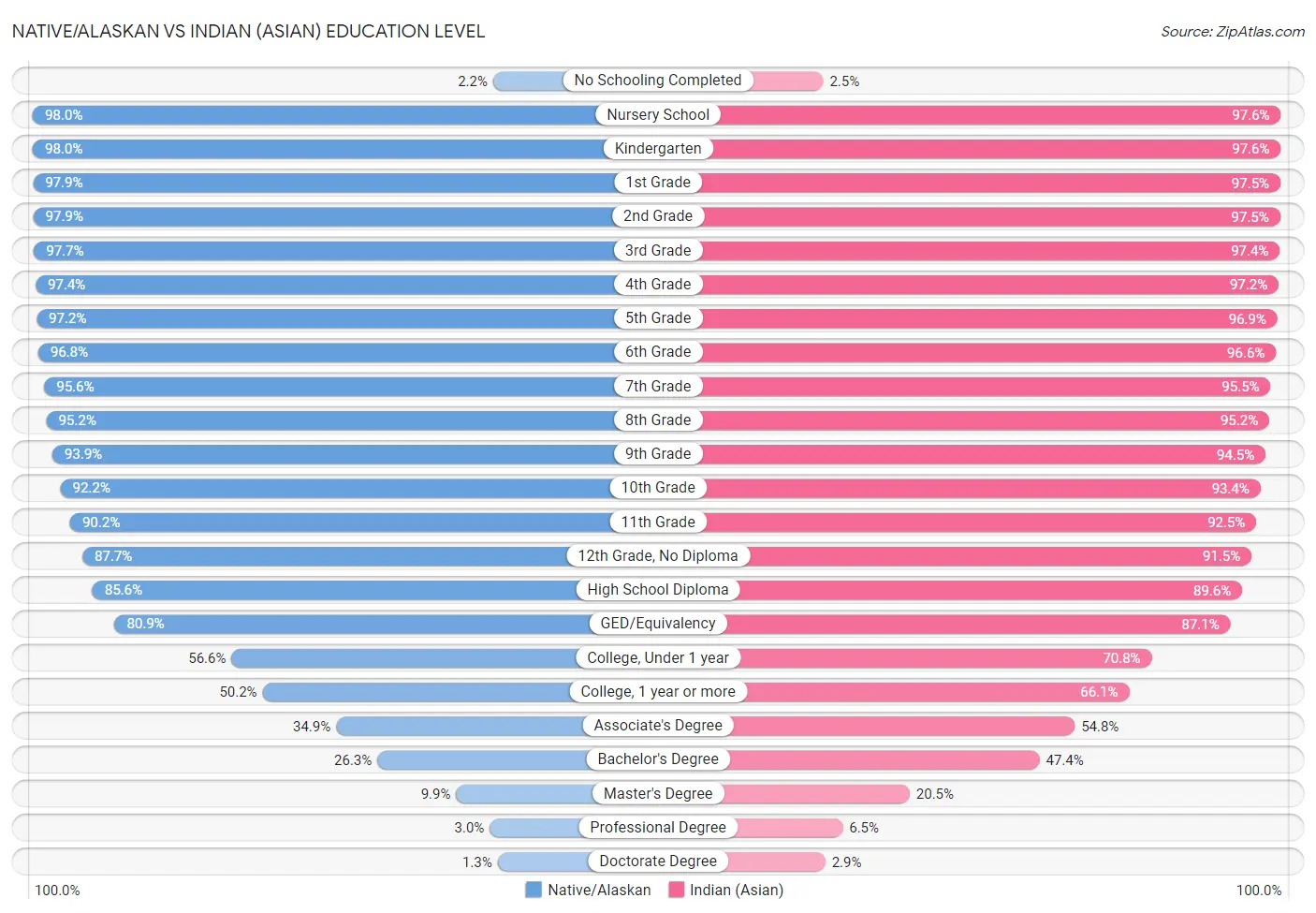
| Education Level Metric | Native/Alaskan | Indian (Asian) |
| No Schooling Completed | Tragic 2.2% | Tragic 2.5% |
| Nursery School | Average 98.0% | Tragic 97.6% |
| Kindergarten | Average 98.0% | Tragic 97.6% |
| 1st Grade | Average 97.9% | Tragic 97.5% |
| 2nd Grade | Average 97.9% | Tragic 97.5% |
| 3rd Grade | Fair 97.7% | Tragic 97.4% |
| 4th Grade | Fair 97.4% | Tragic 97.2% |
| 5th Grade | Poor 97.2% | Tragic 96.9% |
| 6th Grade | Poor 96.8% | Tragic 96.6% |
| 7th Grade | Tragic 95.6% | Tragic 95.5% |
| 8th Grade | Tragic 95.2% | Tragic 95.2% |
| 9th Grade | Tragic 93.9% | Tragic 94.5% |
| 10th Grade | Tragic 92.2% | Poor 93.4% |
| 11th Grade | Tragic 90.2% | Average 92.5% |
| 12th Grade, No Diploma | Tragic 87.7% | Good 91.5% |
| High School Diploma | Tragic 85.6% | Good 89.6% |
| GED/Equivalency | Tragic 80.9% | Exceptional 87.1% |
| College, Under 1 year | Tragic 56.6% | Exceptional 70.8% |
| College, 1 year or more | Tragic 50.2% | Exceptional 66.1% |
| Associate's Degree | Tragic 34.9% | Exceptional 54.8% |
| Bachelor's Degree | Tragic 26.3% | Exceptional 47.4% |
| Master's Degree | Tragic 9.9% | Exceptional 20.5% |
| Professional Degree | Tragic 3.0% | Exceptional 6.5% |
| Doctorate Degree | Tragic 1.3% | Exceptional 2.9% |
Native/Alaskan vs Indian (Asian) Disability
When considering disability, the most significant differences between Native/Alaskan and Indian (Asian) communities in the United States are seen in disability age under 5 (1.9% compared to 1.0%, a difference of 93.9%), disability age 35 to 64 (15.3% compared to 8.9%, a difference of 72.9%), and vision disability (3.0% compared to 1.8%, a difference of 60.5%). Conversely, both communities are more comparable in terms of cognitive disability (18.1% compared to 16.8%, a difference of 7.7%), disability age over 75 (53.1% compared to 46.5%, a difference of 14.1%), and self-care disability (2.8% compared to 2.3%, a difference of 19.9%).
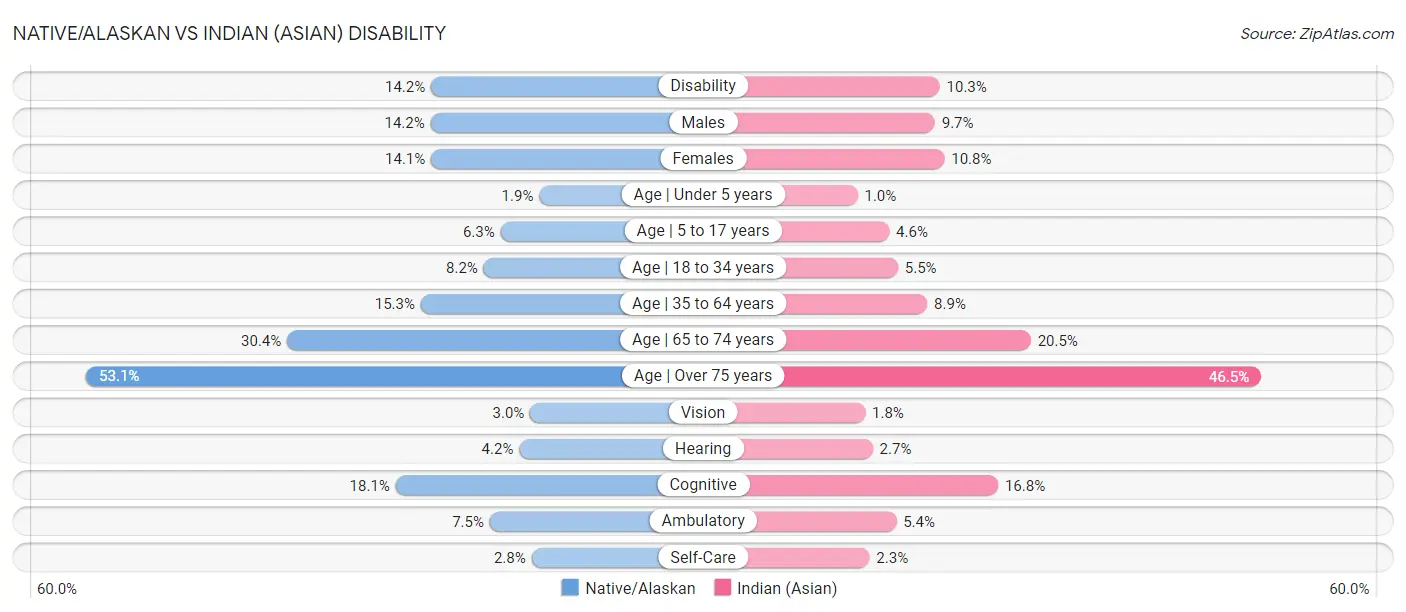
| Disability Metric | Native/Alaskan | Indian (Asian) |
| Disability | Tragic 14.2% | Exceptional 10.3% |
| Males | Tragic 14.2% | Exceptional 9.7% |
| Females | Tragic 14.1% | Exceptional 10.8% |
| Age | Under 5 years | Tragic 1.9% | Exceptional 1.0% |
| Age | 5 to 17 years | Tragic 6.3% | Exceptional 4.6% |
| Age | 18 to 34 years | Tragic 8.2% | Exceptional 5.5% |
| Age | 35 to 64 years | Tragic 15.3% | Exceptional 8.9% |
| Age | 65 to 74 years | Tragic 30.4% | Exceptional 20.5% |
| Age | Over 75 years | Tragic 53.1% | Exceptional 46.5% |
| Vision | Tragic 3.0% | Exceptional 1.8% |
| Hearing | Tragic 4.2% | Exceptional 2.7% |
| Cognitive | Tragic 18.1% | Exceptional 16.8% |
| Ambulatory | Tragic 7.5% | Exceptional 5.4% |
| Self-Care | Tragic 2.8% | Exceptional 2.3% |